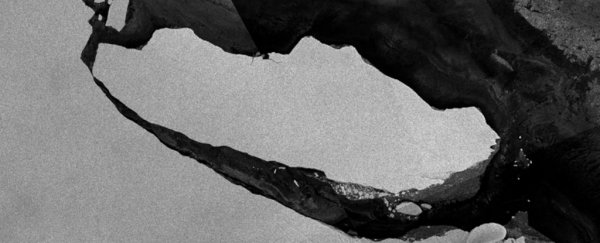When a vast trillion-tonne chunk of ice the size of Delaware broke free from Antarctica in July, it didn't just set loose one of the largest icebergs scientists have ever witnessed.
The massive calving also uncovered a mysterious and precious marine ecosystem hidden under the ice that could have been buried for up to 120,000 years – and it's vital we protect this isolated sanctuary now it's been laid bare.
"I cannot imagine a more dramatic shift in environmental conditions in any ecosystem on Earth," marine ecologist Julian Gutt from the Alfred Wegener Institute for Polar and Marine Research in Germany told Nature.
That epic transition is due to the iceberg – which is called A–68 – drifting and disintegrating northwards into the Weddell Sea and away from its former moorings, the Larsen C ice shelf.
As this migration takes place – whether caused by climate change or not – a vast expanse of ocean and seabed measuring some 5,818 square kilometres (2,246 square miles) is slowly being exposed to sunlight and open marine conditions for what scientists think could be the first time since Earth's last inter-glacial period.
With the wraps coming off this pristine, unexplored environment, scientists are eager to study these unseen waters and the life forms they may contain – and thankfully, they'll now get a chance to do so.
Under an international agreement adopted only last year by the Commission for the Conservation of Antarctic Marine Living Resources (CCAMLR), the emerging ecosystem classifies as a Special Area for Scientific Study, which is granted to newly exposed marine areas following ice-shelf retreat or collapse.
The protections mean the exposed area will carry prohibitions on commercial fishing for at least two years, which can be extended for an extra 10 years – a timeframe designed to give scientists a chance to assess what marine life might exist there already, and to observe new species colonise the freshly uncovered waters.
"It's just a fantastic, unknown area for scientific research," marine biologist Susan Grant from the British Antarctic Survey (BAS) told Live Science.
"We know very little about what might or might not be living in these types of areas, and especially how they might change over time."
Grant was one of the researchers who led the proposal to the CCAMLR for Special Area recognition, and the BAS intends to send a research vessel to study the area in early 2018, provided their funding comes through.
South Korean and German expeditions are also planned for 2018 and 2019 respectively, as researchers race to examine the terrain as early as possible, before exposure to the surface and sunlight yields too many changes to the shielded waters.
"It's very difficult to mobilise research efforts – it takes a lot of money, and ship time is not an easy thing to arrange, especially at short notice," Grant explained to Live Science.
"But the fact that a lot of groups are trying really hard to get something down there demonstrates that this is a really unique opportunity."
As for what scientists can expect to find when they arrive, nobody knows for sure, but the most recent historical precedent for something like this was the collapse of the Larsen A and B ice shelves – in 1995 and 2002.
"Life there is sparse," BAS researcher Phil Trathan told Live Science.
"The working hypothesis is that it is similar to the very deep oceans, but that is something that needs to be tested."
But while these undersea environments devoid of sunlight and food resources may seem like virtual ghost towns, they're still hugely important to study – especially as they won't stay that way for long, with new species beginning to colonise the exposed waters once it emerges.
"You'll have sunlight, you'll have phytoplankton, and you'll begin to get zooplankton and fish in there pretty quickly," Trathan said.
"So, it will be sort of a chain reaction – as you get productivity happening then you'll get more species coming in, and so there will be quite significant changes over relatively short time scales."
The issues of the epic iceberg calving in the first place remain. But now it's done it is a wonderful opportunity to see life adapt to virgin territory – we just have to make it there in time to catch the early show.
